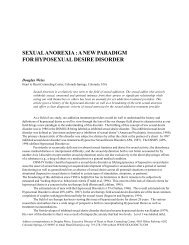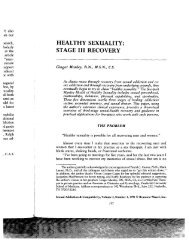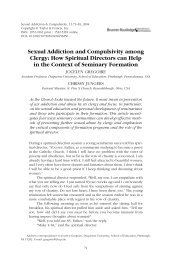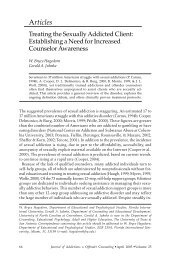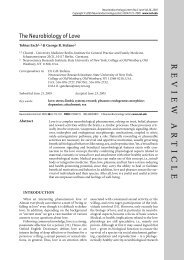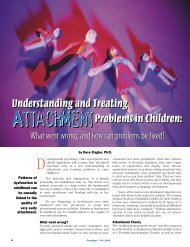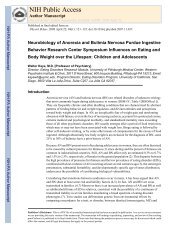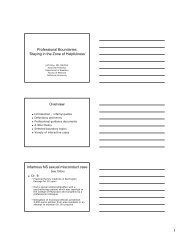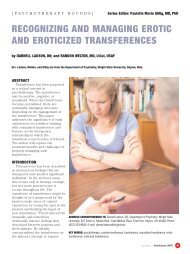Oxytocin increases trust in humans.pdf
Oxytocin increases trust in humans.pdf
Oxytocin increases trust in humans.pdf
You also want an ePaper? Increase the reach of your titles
YUMPU automatically turns print PDFs into web optimized ePapers that Google loves.
Vol 435|2 June 2005|doi:10.1038/nature03701LETTERS<strong>Oxytoc<strong>in</strong></strong> <strong><strong>in</strong>creases</strong> <strong>trust</strong> <strong>in</strong> <strong>humans</strong>Michael Kosfeld 1 *, Markus He<strong>in</strong>richs 2 *, Paul J. Zak 3 , Urs Fischbacher 1 & Ernst Fehr 1,4Trust pervades human societies 1,2 . Trust is <strong>in</strong>dispensable <strong>in</strong> friendship,love, families and organizations, and plays a key role <strong>in</strong>economic exchange and politics 3 . In the absence of <strong>trust</strong> amongtrad<strong>in</strong>g partners, market transactions break down. In the absenceof <strong>trust</strong> <strong>in</strong> a country’s <strong>in</strong>stitutions and leaders, political legitimacybreaks down. Much recent evidence <strong>in</strong>dicates that <strong>trust</strong> contributesto economic, political and social success 4,5 . Little is known,however, about the biological basis of <strong>trust</strong> among <strong>humans</strong>. Herewe show that <strong>in</strong>tranasal adm<strong>in</strong>istration of oxytoc<strong>in</strong>, a neuropeptidethat plays a key role <strong>in</strong> social attachment and affiliation<strong>in</strong> non-human mammals 6–8 , causes a substantial <strong>in</strong>crease <strong>in</strong> <strong>trust</strong>among <strong>humans</strong>, thereby greatly <strong>in</strong>creas<strong>in</strong>g the benefits from social<strong>in</strong>teractions. We also show that the effect of oxytoc<strong>in</strong> on <strong>trust</strong> isnot due to a general <strong>in</strong>crease <strong>in</strong> the read<strong>in</strong>ess to bear risks. On thecontrary, oxytoc<strong>in</strong> specifically affects an <strong>in</strong>dividual’s will<strong>in</strong>gnessto accept social risks aris<strong>in</strong>g through <strong>in</strong>terpersonal <strong>in</strong>teractions.These results concur with animal research suggest<strong>in</strong>g an essentialrole for oxytoc<strong>in</strong> as a biological basis of prosocial approachbehaviour.In non-human mammals, the neuropeptide oxytoc<strong>in</strong> has a centralrole <strong>in</strong> general behavioural regulation, particularly <strong>in</strong> positive social<strong>in</strong>teractions. Aside from its well-known physiological functions <strong>in</strong>milk letdown and dur<strong>in</strong>g labour, oxytoc<strong>in</strong> receptors are distributed<strong>in</strong> various bra<strong>in</strong> regions associated with behaviour 9,10 , <strong>in</strong>clud<strong>in</strong>g pairbond<strong>in</strong>g, maternal care, sexual behaviour, and the ability to formnormal social attachments 6–8,11–15 . Thus, oxytoc<strong>in</strong> seems to permitanimals to overcome their natural avoidance of proximity andthereby facilitates approach behaviour. Given that oxytoc<strong>in</strong> isbelieved to promote social attachment and affiliation <strong>in</strong> nonhumanmammals, we hypothesized that oxytoc<strong>in</strong> might also promoteprosocial approach behaviours—such as <strong>trust</strong>—<strong>in</strong> <strong>humans</strong>.Recent research has shown that neuropeptides cross the blood-bra<strong>in</strong>barrier after <strong>in</strong>tranasal adm<strong>in</strong>istration 16 , provid<strong>in</strong>g a useful methodfor study<strong>in</strong>g the central nervous system effects of oxytoc<strong>in</strong> <strong>in</strong><strong>humans</strong> 17,18 . We used a double-bl<strong>in</strong>d study design to compare<strong>trust</strong><strong>in</strong>g behaviour <strong>in</strong> a group of subjects that received a s<strong>in</strong>gle doseof <strong>in</strong>tranasal oxytoc<strong>in</strong> with that of subjects <strong>in</strong> a control group thatreceived placebo.We analysed the effect of exogenously adm<strong>in</strong>istered oxytoc<strong>in</strong> on<strong>in</strong>dividuals’ decisions <strong>in</strong> a <strong>trust</strong> game with real monetary stakes 19–22 .In this <strong>trust</strong> game, two subjects <strong>in</strong>teract<strong>in</strong>g anonymously play eitherthe role of an <strong>in</strong>vestor or a <strong>trust</strong>ee (Fig. 1). First, the <strong>in</strong>vestor has theoption of choos<strong>in</strong>g a costly <strong>trust</strong><strong>in</strong>g action by giv<strong>in</strong>g money to the<strong>trust</strong>ee. If the <strong>in</strong>vestor transfers money, the total amount available fordistribution between the two players <strong><strong>in</strong>creases</strong> but, <strong>in</strong>itially, the<strong>trust</strong>ee reaps the whole <strong>in</strong>crease. The <strong>trust</strong>ee is then <strong>in</strong>formedabout the <strong>in</strong>vestor’s transfer and can honour the <strong>in</strong>vestor’s <strong>trust</strong> byshar<strong>in</strong>g the monetary <strong>in</strong>crease generated by the <strong>in</strong>vestor’s transfer.Thus, if the <strong>in</strong>vestor gives money to the <strong>trust</strong>ee and the latter sharesthe proceeds of the transfer, both players end up with a highermonetary payoff. However, the <strong>trust</strong>ee also has the option ofviolat<strong>in</strong>g the <strong>in</strong>vestor’s <strong>trust</strong>. As shar<strong>in</strong>g the proceeds is costly forthe <strong>trust</strong>ee, a selfish <strong>trust</strong>ee will never honour the <strong>in</strong>vestor’s <strong>trust</strong>because the <strong>in</strong>vestor and the <strong>trust</strong>ee <strong>in</strong>teract only once dur<strong>in</strong>g theexperiment.The <strong>in</strong>vestor is therefore caught <strong>in</strong> a dilemma: if he <strong>trust</strong>s and the<strong>trust</strong>ee shares, the <strong>in</strong>vestor <strong><strong>in</strong>creases</strong> his payoff, but he is also subjectto the risk that the <strong>trust</strong>ee will abuse this <strong>trust</strong>. In the latter case, the<strong>in</strong>vestor is worse off than if he had not <strong>trust</strong>ed at all and, add<strong>in</strong>g <strong>in</strong>sultto <strong>in</strong>jury, the <strong>trust</strong>ee has an unfair payoff advantage relative to the<strong>in</strong>vestor. Substantial evidence exists to show that <strong>humans</strong> are averseto such risks 22–24 . Moreover, the aversion of <strong>in</strong>vestors to abuse of <strong>trust</strong>seems to have an important role across different human cultures andsocial groups <strong>in</strong> the context of our game 22,25 . The <strong>in</strong>vestors have toovercome their aversion aga<strong>in</strong>st these risks <strong>in</strong> order to <strong>trust</strong>, allow<strong>in</strong>gus to address the question of whether oxytoc<strong>in</strong> modulates this<strong>trust</strong><strong>in</strong>g behaviour <strong>in</strong> <strong>humans</strong>.Figure 1 | The <strong>trust</strong> game. Both subjects receive an <strong>in</strong>itial endowment of 12monetary units (MU). The <strong>in</strong>vestor can send 0, 4, 8 or 12 MU to the <strong>trust</strong>ee.The experimenter triples each MU the <strong>in</strong>vestor transfers. After the <strong>in</strong>vestor’sdecision is made, the <strong>trust</strong>ee is <strong>in</strong>formed about the <strong>in</strong>vestor’s transfer. Thenthe <strong>trust</strong>ee has the option of send<strong>in</strong>g any amount between zero and his totalamount available back to the <strong>in</strong>vestor. For example, if the <strong>in</strong>vestor has sent12 MU, the <strong>trust</strong>ee possesses 48 MU (12 MU own endowment þ 36 MUtripled transfer) and can, therefore choose any back transfer from 0 to48 MUs. The experimenter does not triple the back transfer. The <strong>in</strong>vestor’sf<strong>in</strong>al payoff corresponds to the <strong>in</strong>itial endowment m<strong>in</strong>us the transfer to the<strong>trust</strong>ee, plus the back transfer from the <strong>trust</strong>ee. The <strong>trust</strong>ee’s f<strong>in</strong>al payoff isgiven by his <strong>in</strong>itial endowment plus the tripled transfer of the <strong>in</strong>vestor,m<strong>in</strong>us the back transfer to the <strong>in</strong>vestor. At the end of the experiment, theearned MU are exchanged <strong>in</strong>to real money accord<strong>in</strong>g to a publiclyannounced exchange rate (see Methods). Each subject made four decisions<strong>in</strong> the same player role while paired with four different, randomly selected<strong>in</strong>teraction partners.1 University of Zurich, Institute for Empirical Research <strong>in</strong> Economics, Blumlisalpstrasse 10, CH-8006 Zurich, Switzerland. 2 University of Zurich, Department of Cl<strong>in</strong>ical Psychologyand Psychotherapy, Zurichbergstrasse 43, CH-8044 Zurich, Switzerland. 3 Center for Neuroeconomics Studies, Claremont Graduate University, Claremont, California 91711-6165,USA. 4 Collegium Helveticum, Schmelzbergstrasse 25, CH-8092 Zurich, Switzerland.*These authors contributed equally to this work.© 2005 Nature Publish<strong>in</strong>g Group673
NATURE|Vol 435|2 June 2005LETTERSFigure 3 | Average back transfer of <strong>trust</strong>ees to their <strong>in</strong>vestors. The graphshows the average back transfer by <strong>trust</strong>ees for different levels of <strong>in</strong>vestortransfer <strong>in</strong> the oxytoc<strong>in</strong> and placebo groups. The dotted l<strong>in</strong>e shows the levelof the back transfer necessary to achieve payoff equality between the <strong>in</strong>vestorand the <strong>trust</strong>ee. The dashed l<strong>in</strong>e shows a level of back transfer equal to the<strong>in</strong>vestor’s transfer to the <strong>trust</strong>ee. The <strong>trust</strong>ees’ back transfers are on averageslightly higher than the amount sent by the <strong>in</strong>vestor. Trustees <strong>in</strong> bothtreatment groups make higher back transfers <strong>in</strong> response to higher orig<strong>in</strong>al<strong>in</strong>vestor transfer levels. However, there is no statistically significantdifference <strong>in</strong> back transfers between subjects <strong>in</strong> the oxytoc<strong>in</strong> and the placebogroups.that the effect of oxytoc<strong>in</strong> on human <strong>trust</strong> is not caused by nonspecific,psychotropic effects of oxytoc<strong>in</strong>.What mechanisms might be <strong>in</strong>volved <strong>in</strong> generat<strong>in</strong>g the effect ofoxytoc<strong>in</strong> on <strong>trust</strong><strong>in</strong>g behaviour? One possibility is that oxytoc<strong>in</strong>causes a general <strong>in</strong>crease <strong>in</strong> prosocial <strong>in</strong>cl<strong>in</strong>ations. This implies thatoxytoc<strong>in</strong> should affect not only the prosocial behaviour of the<strong>in</strong>vestors but also that of the <strong>trust</strong>ees. We would therefore predictthat those <strong>trust</strong>ees who are given oxytoc<strong>in</strong> should make higher backtransfers at any given level than the <strong>trust</strong>ees who received placebo.However, <strong>trust</strong>ees given oxytoc<strong>in</strong> do not show more <strong>trust</strong>worthybehaviour (Fig. 3). At every positive transfer level (4, 8 or 12 MU),their back transfers are statistically <strong>in</strong>dist<strong>in</strong>guishable from those ofplacebo <strong>trust</strong>ees (Mann Whitney U-tests; P . 0.243, two-sided testsfor each positive transfer level). Thus, oxytoc<strong>in</strong> does not <strong>in</strong>creasethe general <strong>in</strong>cl<strong>in</strong>ation to behave prosocially. Rather, oxytoc<strong>in</strong>specifically affects the <strong>trust</strong><strong>in</strong>g behaviour of <strong>in</strong>vestors.We hypothesize that the differ<strong>in</strong>g effect of oxytoc<strong>in</strong> on thebehaviour of <strong>in</strong>vestors and <strong>trust</strong>ees is related to the fact that <strong>in</strong>vestorsand <strong>trust</strong>ees face rather different situations. Specifically, <strong>in</strong>vestorshave to make the first step; they have to ‘approach’ the <strong>trust</strong>ee bytransferr<strong>in</strong>g money. In contrast, the <strong>trust</strong>ees can condition theirbehaviour on the basis of the <strong>in</strong>vestors’ actions. Thus, the psychologyof <strong>trust</strong> is important for <strong>in</strong>vestors, whereas the psychology of strongreciprocity 27 is relevant for <strong>trust</strong>ees. The fact that oxytoc<strong>in</strong> affectssubjects’ approach or <strong>trust</strong> behaviour, but not their degree ofreciprocity, is <strong>in</strong> agreement with animal studies. There is substantialevidence that oxytoc<strong>in</strong> promotes prosocial approach behaviour by<strong>in</strong>hibit<strong>in</strong>g defensive behaviours 6,13 , but there is no evidence thatoxytoc<strong>in</strong> affects reciprocity <strong>in</strong> animals.A second mechanism beh<strong>in</strong>d the effect of oxytoc<strong>in</strong> on <strong>trust</strong> couldbe based on subjects’ beliefs. <strong>Oxytoc<strong>in</strong></strong> might render subjects moreoptimistic about the likelihood of a good outcome. In order toaddress this question, we measured the <strong>in</strong>vestor’s subjective expectationabout the <strong>trust</strong>ee’s back transfer after every transfer decision.A Mann-Whitney U-test <strong>in</strong>dicates that these expectations do notdiffer significantly between oxytoc<strong>in</strong> and placebo groups at everyfeasible positive transfer level (P . 0.357, two-sided tests at transferlevels of 4, 8 or 12 MU). Thus, the <strong>in</strong>vestors given oxytoc<strong>in</strong> showmore <strong>trust</strong><strong>in</strong>g behaviour but do not hold significantly differentbeliefs about the <strong>trust</strong>worth<strong>in</strong>ess of others. Moreover, oxytoc<strong>in</strong>© 2005 Nature Publish<strong>in</strong>g Groupdoes not affect <strong>in</strong>vestors’ beliefs about the likelihood of a goodoutcome <strong>in</strong> the risk experiment (P . 0.128, two-sided MannWhitney U-tests for transfer levels of 4, 8 or 12 MU).F<strong>in</strong>ally, there is the possibility that oxytoc<strong>in</strong> helps subjects toovercome their betrayal aversion <strong>in</strong> social <strong>in</strong>teractions. This explanationis consistent with the differ<strong>in</strong>g effects of oxytoc<strong>in</strong> across the<strong>trust</strong> and the risk experiments, and is further supported by the factthat <strong>in</strong>vestors faced a considerable betrayal risk. An <strong>in</strong>crease <strong>in</strong> thetransfer level from 4 or 8 MU to 12 MU decreased the <strong>in</strong>vestor’saverage payoff slightly, whereas it <strong>in</strong>creased the objective risk of verylow back transfers by the <strong>trust</strong>ee. However, betrayal aversion alonecannot expla<strong>in</strong> why <strong>in</strong>vestors given oxytoc<strong>in</strong> make higher transfers <strong>in</strong>the <strong>trust</strong> experiment compared with the risk experiment, becausebetrayal is impossible <strong>in</strong> the risk experiment. The higher transfers <strong>in</strong>the <strong>trust</strong> experiment can be reconciled with betrayal aversion if oneacknowledges that <strong>in</strong>vestors’ behaviour <strong>in</strong> the <strong>trust</strong> experiment is alsolikely to be driven by the motive to <strong>in</strong>crease the available amount fordistribution between the two players 28 . As this motive cannot operate<strong>in</strong> the risk experiment, it can only <strong>in</strong>crease transfers levels <strong>in</strong> the <strong>trust</strong>experiment. Our <strong>in</strong>terpretation of oxytoc<strong>in</strong>’s effect on <strong>trust</strong> <strong>in</strong> termsof betrayal aversion may be seen <strong>in</strong> the light of animal studies<strong>in</strong>dicat<strong>in</strong>g that <strong>in</strong>creased availability of oxytoc<strong>in</strong> <strong>in</strong> the centralnervous system facilitates approach behaviour, by l<strong>in</strong>k<strong>in</strong>g the overcom<strong>in</strong>gof social avoidance with the activation of bra<strong>in</strong> circuitsimplicated <strong>in</strong> reward (for example, the nucleus accumbens) 12,15 .The ubiquity of <strong>trust</strong><strong>in</strong>g behaviour is perhaps one of the dist<strong>in</strong>guish<strong>in</strong>gfeatures of the human species. An element of <strong>trust</strong>characterizes almost all human social <strong>in</strong>teractions. Here we havesought to exam<strong>in</strong>e the effect of oxytoc<strong>in</strong> on <strong>trust</strong> <strong>in</strong> <strong>humans</strong>.Research <strong>in</strong> non-human mammals suggests that oxytoc<strong>in</strong> has a keyrole <strong>in</strong> social attachment and affiliation. We f<strong>in</strong>d that <strong>in</strong>tranasaladm<strong>in</strong>istration of oxytoc<strong>in</strong> causes a substantial <strong>in</strong>crease <strong>in</strong> <strong>trust</strong><strong>in</strong>gbehaviour. Subjects given oxytoc<strong>in</strong> seem better able to overcome<strong>trust</strong> obstacles such as betrayal aversion. Of course, this f<strong>in</strong>d<strong>in</strong>g couldbe misused to <strong>in</strong>duce <strong>trust</strong><strong>in</strong>g behaviours that selfish actors subsequentlyexploit. However, our f<strong>in</strong>d<strong>in</strong>gs may also have positivecl<strong>in</strong>ical implications for patients with mental disorders that areassociated with social dysfunctions (for example, social phobia orautism). In particular, social phobia ranks as the third most commonmental health disorder and is characterized by marked social deficits,<strong>in</strong>clud<strong>in</strong>g persistent fear and avoidance of social <strong>in</strong>teractions. Thus,our results might lead to fertile research on the role of oxytoc<strong>in</strong> <strong>in</strong>several mental health disorders with major public health significance.METHODSSubjects. A total of 194 healthy male students (mean age ^ s.d., 22.0 ^ 3.4 yr)from different universities <strong>in</strong> Zurich participated <strong>in</strong> the study. The <strong>trust</strong>experiment had 128 participants, and 66 subjects participated <strong>in</strong> the riskexperiment. Exclusion criteria for participation were significant medical orpsychiatric illness, medication, smok<strong>in</strong>g more than 15 cigarettes per day, anddrug or alcohol abuse. Subjects were <strong>in</strong>structed to absta<strong>in</strong> from food and dr<strong>in</strong>k(other than water) for 2 h before the experiment, and from alcohol, smok<strong>in</strong>g andcaffe<strong>in</strong>e for 24 h before the experiment. Participants were <strong>in</strong>formed at the time ofrecruitment that the experiment would evaluate the effects of a hormone ondecision mak<strong>in</strong>g. In total, 16 <strong>in</strong>dividuals out of the orig<strong>in</strong>al sample of 194 wereexcluded because of <strong>in</strong>correct substance adm<strong>in</strong>istration (7 <strong>in</strong> the <strong>trust</strong> experiment,5 <strong>in</strong> the risk experiment) or their stated disbelief that the opponent <strong>in</strong> the<strong>trust</strong> game was actually a human be<strong>in</strong>g (4 participants). The study protocol wasapproved by the ethics committee of the University of Zurich. All subjects gavewritten, <strong>in</strong>formed consent before participation.Substance adm<strong>in</strong>istration. Subjects received a s<strong>in</strong>gle <strong>in</strong>tranasal dose of 24 IUoxytoc<strong>in</strong> (Syntoc<strong>in</strong>on-Spray, Novartis; 3 puffs per nostril, each with 4 IUoxytoc<strong>in</strong>) or placebo 50 m<strong>in</strong> before the start of the <strong>trust</strong> or the risk experiment.Subjects were randomly assigned to the oxytoc<strong>in</strong> or placebo group (doublebl<strong>in</strong>d,placebo-controlled study design). In order to avoid any subjectivesubstance effects (for example, olfactory effects) other than those caused byoxytoc<strong>in</strong>, the placebo conta<strong>in</strong>ed all <strong>in</strong>active <strong>in</strong>gredients except for theneuropeptide.Behavioural experiment and questionnaires. After substance adm<strong>in</strong>istration,675



